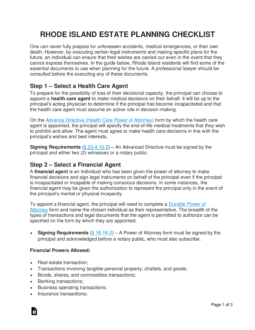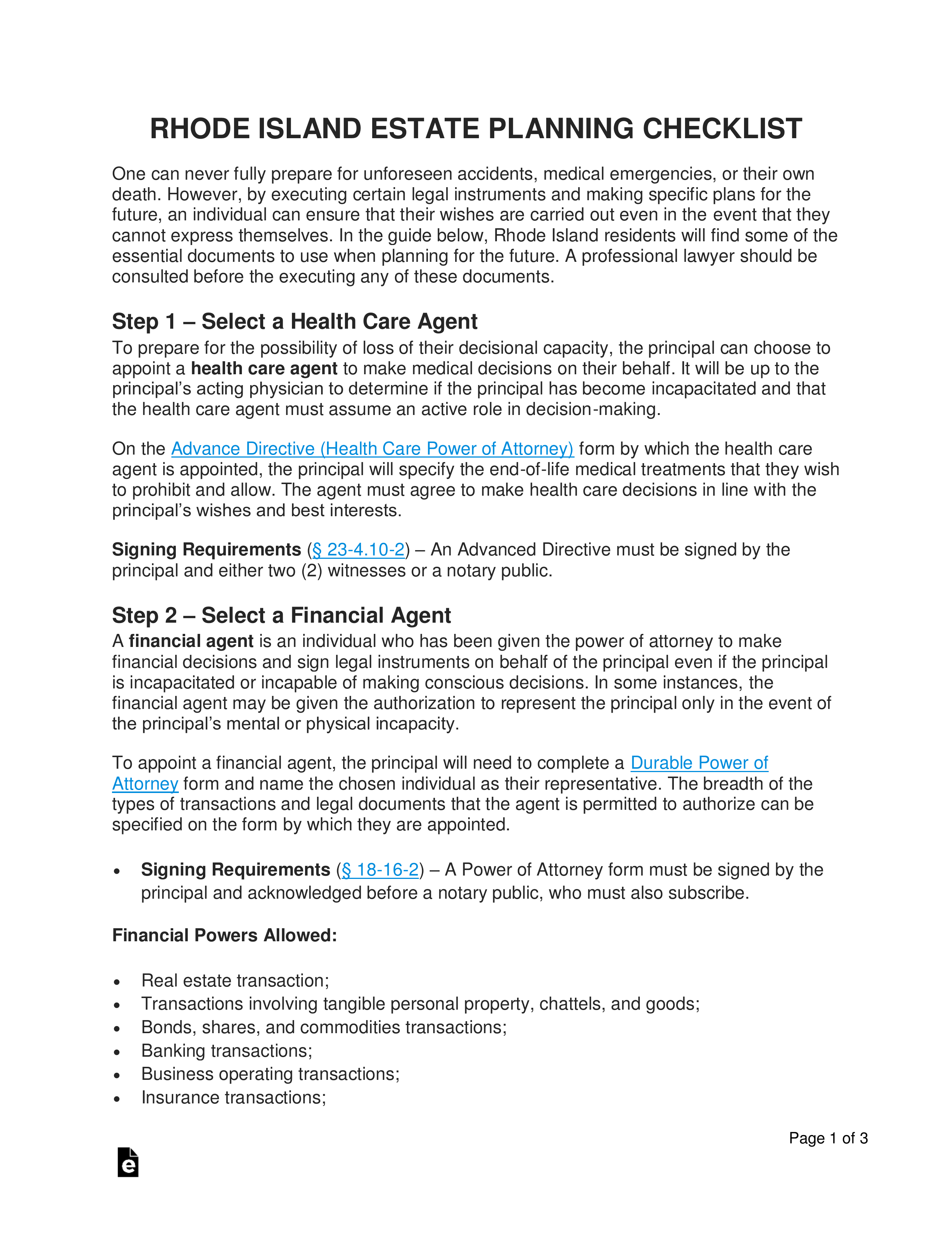Updated March 05, 2024
A Rhode Island estate planning checklist is a guide that can help residents get started with planning for the distribution of their estate, as well as end-of-life medical treatment. For the administration of their estate, individuals will need to complete a Last Will and Testament, Revocable Living Trust, or another appropriate legal instrument. To plan the management of their affairs in the event of their mental or physical incapacity, individuals may execute an Advance Directive (Health Care Power of Attorney) and a Durable Power of Attorney to appoint representatives to act on their behalf if such a circumstance should arise.
How to Create an Estate Plan in Rhode Island (6 steps)
- Select a Health Care Agent
- Select a Financial Agent
- Make a List of All Estate Items
- Designate Beneficiaries and Other Roles
- Execute Estate Transfer Documents
- Keep the Documents Safe
One can never fully prepare for unforeseen accidents, medical emergencies, or their own death. However, by executing certain legal instruments and making specific plans for the future, an individual can ensure that their wishes are carried out even in the event that they cannot express themselves. In the guide below, Rhode Island residents will find some of the essential documents to use when planning for the future. A professional lawyer should be consulted before the executing any of these documents.
1. Select a Health Care Agent
On the Advance Directive (Health Care Power of Attorney) form by which the health care agent is appointed, the principal will specify the end-of-life medical treatments that they wish to prohibit and allow. The agent must agree to make health care decisions in line with the principal’s wishes and best interests.
Signing Requirements – An Advanced Directive must be signed by the principal and either two (2) witnesses or a notary public.[1]
2. Select a Financial Agent
A financial agent is an individual who has been given the power of attorney to make financial decisions and sign legal instruments on behalf of the principal even if the principal is incapacitated or incapable of making conscious decisions. In some instances, the financial agent may be given the authorization to represent the principal only in the event of the principal’s mental or physical incapacity.
To appoint a financial agent, the principal will need to complete a Durable Power of Attorney form and name the chosen individual as their representative. The breadth of the types of transactions and legal documents that the agent is permitted to authorize can be specified on the form by which they are appointed.
- Signing Requirements – A Power of Attorney form must be signed by the principal and acknowledged before a notary public, who must also subscribe.[2]
Financial Powers Allowed:
- Real estate transaction;
- Transactions involving tangible personal property, chattels, and goods;
- Bonds, shares, and commodities transactions;
- Banking transactions;
- Business operating transactions;
- Insurance transactions;
- Estate transactions;
- Gift transactions;
- Claims and litigation;
- Personal relationships and affairs;
- Benefits from government programs and military service;
- Records, reports, and statements;
- Delegation;
- Voter registration and absentee ballot requests; and
- and other requests as allowed within the State by the Principal.
3. Make a List of All Estate Items
4. Designate Beneficiaries and Other Roles
5. Execute Estate Transfer Documents
Once they have decided how their estate will be divided and to whom, the principal must select the legal instrument through which their wishes will be communicated. There are two (2) different options that are usually chosen to plan the distribution of an individual’s property (described below).
Last Will and Testament – The most known and commonly used legal document used to plan the administration of an individual’s estate after they die. Unlike a Living Trust, a Will only becomes active when the principal (called “the testator”) dies. Before being distributed to the testator’s beneficiaries, the Will must go through the probate court.
- Signing Requirements – State law requires a Will to be signed by the testator (or a representative who signs in the testator’s conscious presence) and two (2) witnesses.[3]
Revocable Living Trust – In a Living Trust, the principal (called “the grantor”) signs over the ownership of their assets and property to an entity (the Trust). The grantor may appoint themselves as a trustee and continue to benefit from their estate during their lifetime. The main benefit of the Living Trust is that the grantor’s estate will be available to its beneficiaries after their death and will not have to pass through the probate process.
- Signing Requirements – A Living Trust only requires the signature of the grantor.[4]
6. Keep the Documents Safe
Rhode Island Estate Planning Laws
- Advance Health Care Directive – Chapter 23-4.10 – Health Care Power of Attorney
- Durable Power of Attorney – Chapter 18-16 – Short Form Power of Attorney Act
- Last Will and Testament – Title 33 – Probate Process and Procedure
- Living Trust (Revocable) – Title 18 – Power of Fiduciaries


